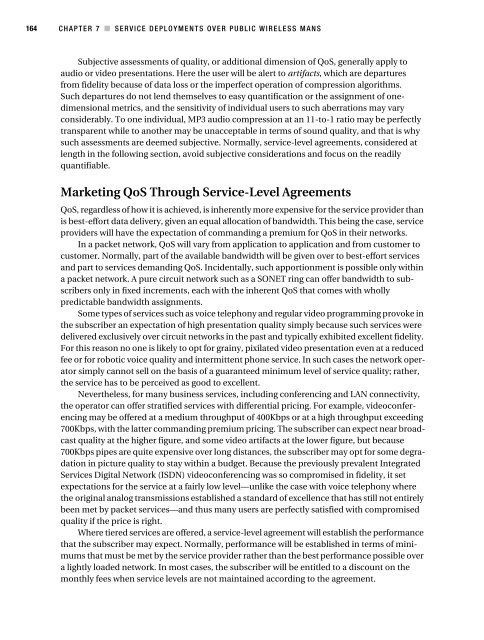WiMax Operator's Manual
WiMax Operator's Manual
WiMax Operator's Manual
Create successful ePaper yourself
Turn your PDF publications into a flip-book with our unique Google optimized e-Paper software.
164 CHAPTER 7 ■ SERVICE DEPLOYMENTS OVER PUBLIC WIRELESS MANS<br />
Subjective assessments of quality, or additional dimension of QoS, generally apply to<br />
audio or video presentations. Here the user will be alert to artifacts, which are departures<br />
from fidelity because of data loss or the imperfect operation of compression algorithms.<br />
Such departures do not lend themselves to easy quantification or the assignment of onedimensional<br />
metrics, and the sensitivity of individual users to such aberrations may vary<br />
considerably. To one individual, MP3 audio compression at an 11-to-1 ratio may be perfectly<br />
transparent while to another may be unacceptable in terms of sound quality, and that is why<br />
such assessments are deemed subjective. Normally, service-level agreements, considered at<br />
length in the following section, avoid subjective considerations and focus on the readily<br />
quantifiable.<br />
Marketing QoS Through Service-Level Agreements<br />
QoS, regardless of how it is achieved, is inherently more expensive for the service provider than<br />
is best-effort data delivery, given an equal allocation of bandwidth. This being the case, service<br />
providers will have the expectation of commanding a premium for QoS in their networks.<br />
In a packet network, QoS will vary from application to application and from customer to<br />
customer. Normally, part of the available bandwidth will be given over to best-effort services<br />
and part to services demanding QoS. Incidentally, such apportionment is possible only within<br />
a packet network. A pure circuit network such as a SONET ring can offer bandwidth to subscribers<br />
only in fixed increments, each with the inherent QoS that comes with wholly<br />
predictable bandwidth assignments.<br />
Some types of services such as voice telephony and regular video programming provoke in<br />
the subscriber an expectation of high presentation quality simply because such services were<br />
delivered exclusively over circuit networks in the past and typically exhibited excellent fidelity.<br />
For this reason no one is likely to opt for grainy, pixilated video presentation even at a reduced<br />
fee or for robotic voice quality and intermittent phone service. In such cases the network operator<br />
simply cannot sell on the basis of a guaranteed minimum level of service quality; rather,<br />
the service has to be perceived as good to excellent.<br />
Nevertheless, for many business services, including conferencing and LAN connectivity,<br />
the operator can offer stratified services with differential pricing. For example, videoconferencing<br />
may be offered at a medium throughput of 400Kbps or at a high throughput exceeding<br />
700Kbps, with the latter commanding premium pricing. The subscriber can expect near broadcast<br />
quality at the higher figure, and some video artifacts at the lower figure, but because<br />
700Kbps pipes are quite expensive over long distances, the subscriber may opt for some degradation<br />
in picture quality to stay within a budget. Because the previously prevalent Integrated<br />
Services Digital Network (ISDN) videoconferencing was so compromised in fidelity, it set<br />
expectations for the service at a fairly low level—unlike the case with voice telephony where<br />
the original analog transmissions established a standard of excellence that has still not entirely<br />
been met by packet services—and thus many users are perfectly satisfied with compromised<br />
quality if the price is right.<br />
Where tiered services are offered, a service-level agreement will establish the performance<br />
that the subscriber may expect. Normally, performance will be established in terms of minimums<br />
that must be met by the service provider rather than the best performance possible over<br />
a lightly loaded network. In most cases, the subscriber will be entitled to a discount on the<br />
monthly fees when service levels are not maintained according to the agreement.
















